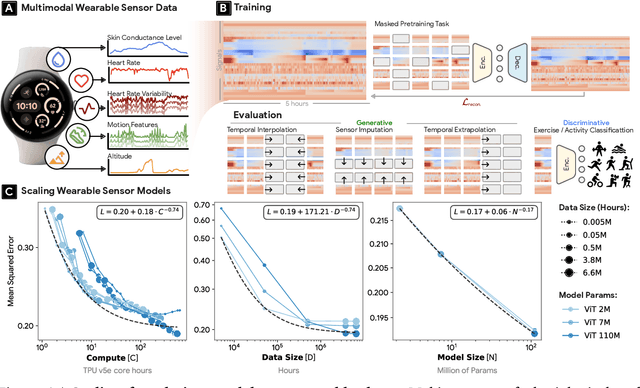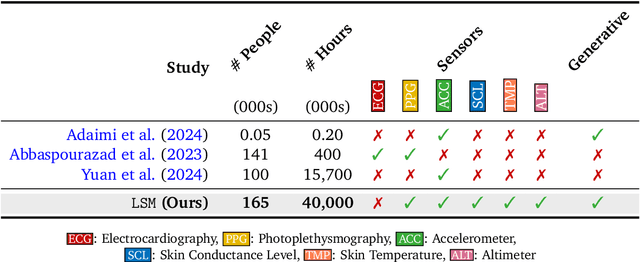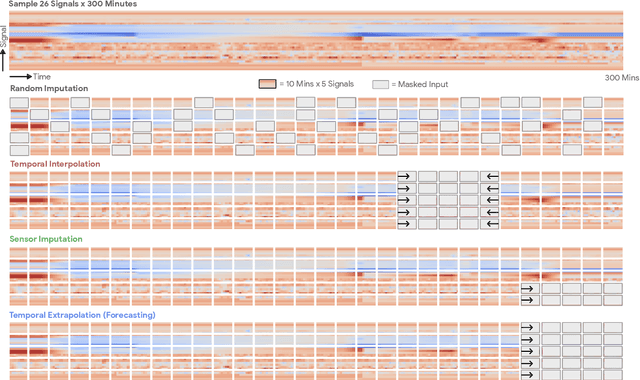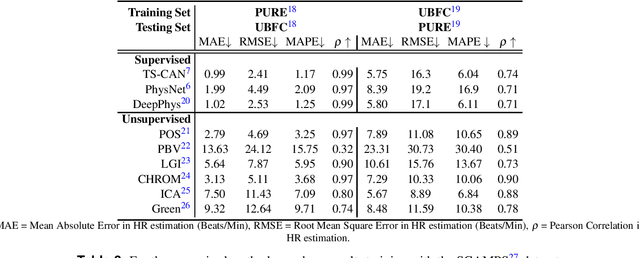Girish Narayanswamy
SensorLM: Learning the Language of Wearable Sensors
Jun 10, 2025Abstract:We present SensorLM, a family of sensor-language foundation models that enable wearable sensor data understanding with natural language. Despite its pervasive nature, aligning and interpreting sensor data with language remains challenging due to the lack of paired, richly annotated sensor-text descriptions in uncurated, real-world wearable data. We introduce a hierarchical caption generation pipeline designed to capture statistical, structural, and semantic information from sensor data. This approach enabled the curation of the largest sensor-language dataset to date, comprising over 59.7 million hours of data from more than 103,000 people. Furthermore, SensorLM extends prominent multimodal pretraining architectures (e.g., CLIP, CoCa) and recovers them as specific variants within a generic architecture. Extensive experiments on real-world tasks in human activity analysis and healthcare verify the superior performance of SensorLM over state-of-the-art in zero-shot recognition, few-shot learning, and cross-modal retrieval. SensorLM also demonstrates intriguing capabilities including scaling behaviors, label efficiency, sensor captioning, and zero-shot generalization to unseen tasks.
RADAR: Benchmarking Language Models on Imperfect Tabular Data
Jun 09, 2025Abstract:Language models (LMs) are increasingly being deployed to perform autonomous data analyses. However, their data awareness -- the ability to recognize, reason over, and appropriately handle data artifacts such as missing values, outliers, and logical inconsistencies -- remains underexplored. These artifacts are especially common in real-world tabular data and, if mishandled, can significantly compromise the validity of analytical conclusions. To address this gap, we present RADAR, a benchmark for systematically evaluating data-aware reasoning on tabular data. We develop a framework to simulate data artifacts via programmatic perturbations to enable targeted evaluation of model behavior. RADAR comprises 2980 table query pairs, grounded in real-world data spanning 9 domains and 5 data artifact types. In addition to evaluating artifact handling, RADAR systematically varies table size to study how reasoning performance holds when increasing table size. Our evaluation reveals that, despite decent performance on tables without data artifacts, frontier models degrade significantly when data artifacts are introduced, exposing critical gaps in their capacity for robust, data-aware analysis. Designed to be flexible and extensible, RADAR supports diverse perturbation types and controllable table sizes, offering a valuable resource for advancing tabular reasoning.
LSM-2: Learning from Incomplete Wearable Sensor Data
Jun 05, 2025Abstract:Foundation models, a cornerstone of recent advancements in machine learning, have predominantly thrived on complete and well-structured data. Wearable sensor data frequently suffers from significant missingness, posing a substantial challenge for self-supervised learning (SSL) models that typically assume complete data inputs. This paper introduces the second generation of Large Sensor Model (LSM-2) with Adaptive and Inherited Masking (AIM), a novel SSL approach that learns robust representations directly from incomplete data without requiring explicit imputation. AIM's core novelty lies in its use of learnable mask tokens to model both existing ("inherited") and artificially introduced missingness, enabling it to robustly handle fragmented real-world data during inference. Pre-trained on an extensive dataset of 40M hours of day-long multimodal sensor data, our LSM-2 with AIM achieves the best performance across a diverse range of tasks, including classification, regression and generative modeling. Furthermore, LSM-2 with AIM exhibits superior scaling performance, and critically, maintains high performance even under targeted missingness scenarios, reflecting clinically coherent patterns, such as the diagnostic value of nighttime biosignals for hypertension prediction. This makes AIM a more reliable choice for real-world wearable data applications.
Scaling Wearable Foundation Models
Oct 17, 2024



Abstract:Wearable sensors have become ubiquitous thanks to a variety of health tracking features. The resulting continuous and longitudinal measurements from everyday life generate large volumes of data; however, making sense of these observations for scientific and actionable insights is non-trivial. Inspired by the empirical success of generative modeling, where large neural networks learn powerful representations from vast amounts of text, image, video, or audio data, we investigate the scaling properties of sensor foundation models across compute, data, and model size. Using a dataset of up to 40 million hours of in-situ heart rate, heart rate variability, electrodermal activity, accelerometer, skin temperature, and altimeter per-minute data from over 165,000 people, we create LSM, a multimodal foundation model built on the largest wearable-signals dataset with the most extensive range of sensor modalities to date. Our results establish the scaling laws of LSM for tasks such as imputation, interpolation and extrapolation, both across time and sensor modalities. Moreover, we highlight how LSM enables sample-efficient downstream learning for tasks like exercise and activity recognition.
Exploring and Characterizing Large Language Models For Embedded System Development and Debugging
Jul 07, 2023Abstract:Large language models (LLMs) have shown remarkable abilities to generate code, however their ability to develop software for embedded systems, which requires cross-domain knowledge of hardware and software has not been studied. In this paper we systematically evaluate leading LLMs (GPT-3.5, GPT-4, PaLM 2) to assess their performance for embedded system development, study how human programmers interact with these tools, and develop an AI-based software engineering workflow for building embedded systems. We develop an an end-to-end hardware-in-the-loop evaluation platform for verifying LLM generated programs using sensor actuator pairs. We compare all three models with N=450 experiments and find surprisingly that GPT-4 especially shows an exceptional level of cross-domain understanding and reasoning, in some cases generating fully correct programs from a single prompt. In N=50 trials, GPT-4 produces functional I2C interfaces 66% of the time. GPT-4 also produces register-level drivers, code for LoRa communication, and context-specific power optimizations for an nRF52 program resulting in over 740x current reduction to 12.2 uA. We also characterize the models' limitations to develop a generalizable workflow for using LLMs in embedded system development. We evaluate the workflow with 15 users including novice and expert programmers. We find that our workflow improves productivity for all users and increases the success rate for building a LoRa environmental sensor from 25% to 100%, including for users with zero hardware or C/C++ experience.
BigSmall: Efficient Multi-Task Learning for Disparate Spatial and Temporal Physiological Measurements
Mar 21, 2023Abstract:Understanding of human visual perception has historically inspired the design of computer vision architectures. As an example, perception occurs at different scales both spatially and temporally, suggesting that the extraction of salient visual information may be made more effective by paying attention to specific features at varying scales. Visual changes in the body due to physiological processes also occur at different scales and with modality-specific characteristic properties. Inspired by this, we present BigSmall, an efficient architecture for physiological and behavioral measurement. We present the first joint camera-based facial action, cardiac, and pulmonary measurement model. We propose a multi-branch network with wrapping temporal shift modules that yields both accuracy and efficiency gains. We observe that fusing low-level features leads to suboptimal performance, but that fusing high level features enables efficiency gains with negligible loss in accuracy. Experimental results demonstrate that BigSmall significantly reduces the computational costs. Furthermore, compared to existing task-specific models, BigSmall achieves comparable or better results on multiple physiological measurement tasks simultaneously with a unified model.
Deep Physiological Sensing Toolbox
Oct 03, 2022


Abstract:Camera physiological measurement is a fast growing field of computer vision. Remote photoplethysmography (rPPG) uses video cameras (imagers) to measure the peripheral blood volume pulse (BVP). Simply, this enables heart rate measurement via webcams, smartphone cameras and many other imaging devices. The current state-of-the-art methods are supervised deep neural architectures that have large numbers of parameters and a signal number of hyperparameters. Replication of results and benchmarking of new models is critical for scientific progress. However, as with many other applications of deep learning, reliable codebases are not easy to find. We present a comprehensive toolbox, rPPG-Toolbox, containing code for training and evaluating unsupervised and supervised rPPG models: https://github.com/ubicomplab/rPPG-Toolbox
 Add to Chrome
Add to Chrome Add to Firefox
Add to Firefox Add to Edge
Add to Edge